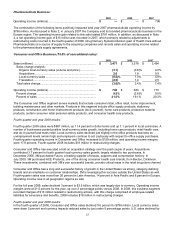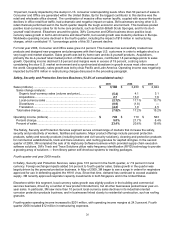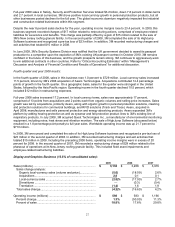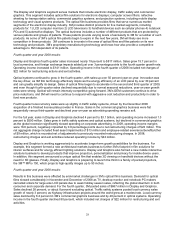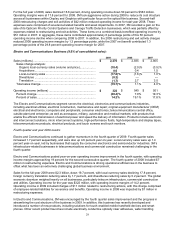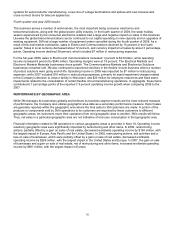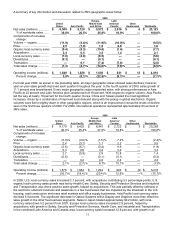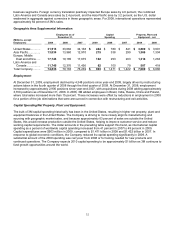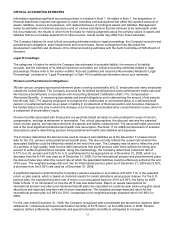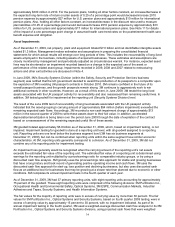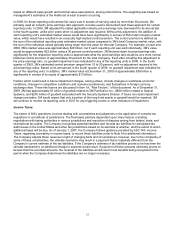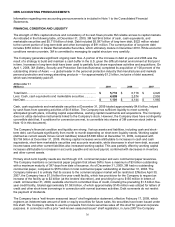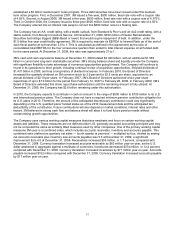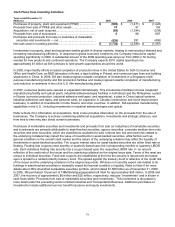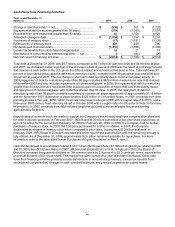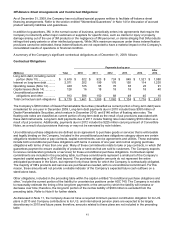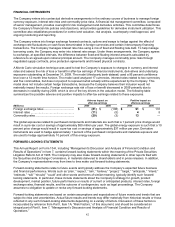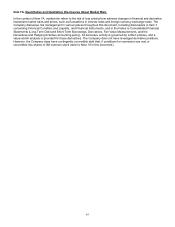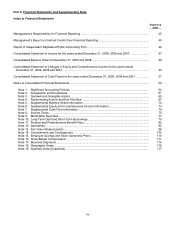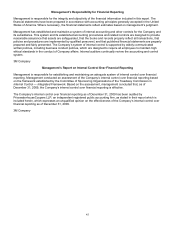3M 2009 Annual Report Download - page 41
Download and view the complete annual report
Please find page 41 of the 2009 3M annual report below. You can navigate through the pages in the report by either clicking on the pages listed below, or by using the keyword search tool below to find specific information within the annual report. 35
based on different sales growth and terminal value assumptions, among other factors. The weighting was based on
management’s estimates of the likelihood of each scenario occurring.
In 2009, for those reporting units whose fair value was in excess of carrying value by more than 30 percent, 3M
primarily used an industry price-earnings ratio approach, but also used a discounted cash flows approach for certain
reporting units. In 2008, 3M adjusted the stated applicable industry price-earnings ratio downward for its annual test
in the fourth quarter, unlike prior years when no adjustment was required. Without this adjustment, the addition of
each reporting unit’s estimated market values would have been significantly in excess of 3M’s total Company market
value, which would have resulted in an unusually high implied control premium. The control premium is defined as
the sum of the individual reporting units estimated market values compared to 3M’s total Company market value, with
the sum of the individual values typically being larger than the value for the total Company. For example, at year-end
2008, 3M’s market value was approximately $40 billion, but if each reporting unit was sold individually, 3M’s value
would be approximately $52 billion using a 30 percent control premium. 3M factored down its price/earnings ratio
significantly for the respective reporting units to approximate what the price/earnings ratio would be at a more normal
historical control premium of approximately 30 percent for the total Company. Even after including this adjustment to
the price-earnings ratio, no goodwill impairment was indicated for any of the reporting units in 2008. In the fourth
quarter of 2009, 3M’s estimated control premium ranged from 15 to 30 percent, with no adjustment required to the
price/earnings ratios. Based on its annual test in the fourth quarter of 2009, no goodwill impairment was indicated for
any of the reporting units. In addition, 3M’s market value at December 31, 2009 of approximately $59 billion is
significantly in excess of its equity of approximately $13 billion.
Factors which could result in future impairment charges, among others, include changes in worldwide economic
conditions, changes in competitive conditions and customer preferences, and fluctuations in foreign currency
exchange rates. These risk factors are discussed in Item 1A, “Risk Factors,” of this document. As of December 31,
2009, 3M had approximately $1 billion of goodwill related to 3M Purification Inc., $800 million related to Optical
Systems, and $200 million of goodwill associated with the Security Systems Division. If future non-cash impairment
charges are taken, 3M would expect that only a portion of the long-lived assets or goodwill would be impaired. 3M
will continue to monitor its reporting units in 2010 for any triggering events or other indicators of impairment.
Income Taxes:
The extent of 3M’s operations involves dealing with uncertainties and judgments in the application of complex tax
regulations in a multitude of jurisdictions. The final taxes paid are dependent upon many factors, including
negotiations with taxing authorities in various jurisdictions and resolution of disputes arising from federal, state, and
international tax audits. The Company recognizes potential liabilities and records tax liabilities for anticipated tax
audit issues in the United States and other tax jurisdictions based on its estimate of whether, and the extent to which,
additional taxes will be due. As of January 1, 2007, the Company follows guidance provided by ASC 740, Income
Taxes, regarding uncertainty in income taxes, to record these liabilities (refer to Note 8 for additional information).
The Company adjusts these reserves in light of changing facts and circumstances; however, due to the complexity of
some of these uncertainties, the ultimate resolution may result in a payment that is materially different from the
Company’s current estimate of the tax liabilities. If the Company’s estimate of tax liabilities proves to be less than the
ultimate assessment, an additional charge to expense would result. If payment of these amounts ultimately proves to
be less than the recorded amounts, the reversal of the liabilities would result in tax benefits being recognized in the
period when the Company determines the liabilities are no longer necessary.


